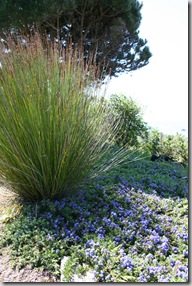
When talking with another designer recently, she said something that stuck in my head: “Lawn? We call that “green concrete”. Sure, sometimes you need a bit of it here or there, but it brings so little to the table that we try to avoid it!”
And it’s true!
I love sunning myself and playing with the cats on my small lawn, but I’m pretty cognizant of the fact that every inch of lawn is taking up space that could be used for something more productive.
Even an organic, no water, manually-mowed, unfertilized lawn like my own, is simply doing no harm. But it’s missing an opportunity to do good. Lawn:
- Takes time and resources to care for
- Doesn’t feed either people or wildlife
- Isn’t all that exciting to look at (we’re past the point as a society where we admired people for their green Chemlawns, right?)
- Is often a choice we make by omission, by not taking the initiative to do something more intentional with our space
However, I’m not a huge advocate for getting rid of lawn entirely, because I think our human interaction with our gardens is important. If you actually go out and enjoy your lawn like I do, then it’s not a waste. It’s just good to periodically remember that the things in our gardens are either making a positive difference in the world (to us, or to wildlife), or they’re taking up space that could have been used for something better.
So if you’ve got a dead zone that’s neither making you happy nor improving your life, whether it’s lawn or something else, why not rip it up and do something useful with it?
Here are some ways you can make a difference:
Take the slow route to beautification. Slowly chip away at the edges of your lawn, and plant tumbling masses of low native groundcovers, caterpillar host plants, or native perennials which feed pollinators. This can provide habitat for frogs and salamanders, breeding grounds for butterflies, and food to keep the butterflies coming.
Add a water feature. Carve out a section of boring old lawn and put in a pond instead. Dragonflies are forever scanning the ground for a hint of something shiny that may indicate water, as they need water to reproduce. My humble little 2′ by 4′ pond attracts frogs, dragonflies, and other wildlife, and I can tell you that no matter how many times I see a dragonfly hovering over the garden or hear a frog chirruping to its pals, it never fails to give me a moment of sheer joy.
Decide whether a patio might be more useful. A lot of us keep lawns because they’re an easy space to set up a couple chairs and relax. But because a patio is so user-friendly, I find people are much happier spending time on a small patio (set within the garden) rather than trying to entertain on a large area of lawn. That means more space can be set aside for the plantings, ponds, compost pile and other elements which benefit you and bring the wildlife flocking. (Get tips for choosing the shape of a patio here.)
Get inspired. Books such as Reimagining the California Lawn, Beautiful No-Mow Yards
, and the yet-to-be-released Lawn Gone!
all show some great ideas, many of which are either wildlife-friendly already, or have the potential to be so with plant choices appropriate to your area (more about picking wildlife-friendly plants here).
Check out these photos of no-lawn or less-lawn garden spaces:
Native perennials and grasses plus some trees creates a more compelling front yard design than just a postage stamp of green with a foundation planting.
This sloping front yard gets a wildlife-friendly makeover with a rich planting of natives.
This contemporary and Asian-inspired space has color, interest, and doesn’t rely on lawn. Choose native grasses instead of the Mexican feather grass for a garden as attractive to birds as it is to people.
A rustic-style garden lends itself well to a more natural, flowing look.
Inspired by the waves of the ocean, this designer created curling pathways within the landscaping so visitors can enjoy the plantings and happy butterflies and bees.
Not a fan of ornamental grasses? This coastal landscape bursts into vivid summer bloom. While there’s still some lawn, the owners have obviously taken care to pack plantings into the garden beds. Lean more heavily on native plants to attract wildlife, if you go with this style.
The backdrop of shrubs and trees in this cozy patio setting provides ample places for wildlife to shelter.
Pathways, plantings, and a water feature? Sounds good to me. Fill up your water feature all the way and add a small “beach” of pebbles on one side so butterflies and birds have a place to land.
Are you feeling as inspired as I am? Lawn contributes so little to the landscape that we want to make sure we’re only using it in the places where it’s appreciated and wanted. Check out some of the book ideas above to get new ideas about creating a no-lawn garden rich in the beauty of wildlife.
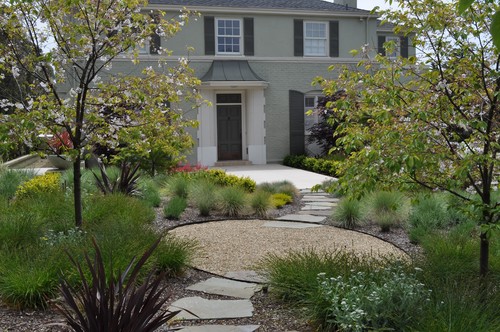
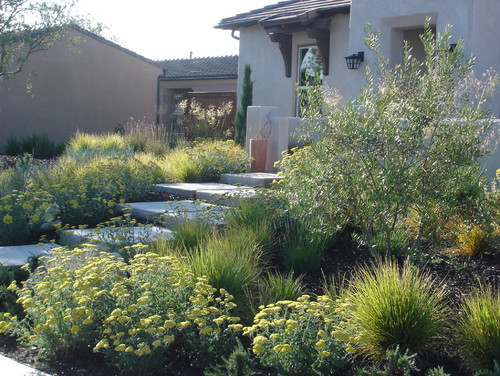
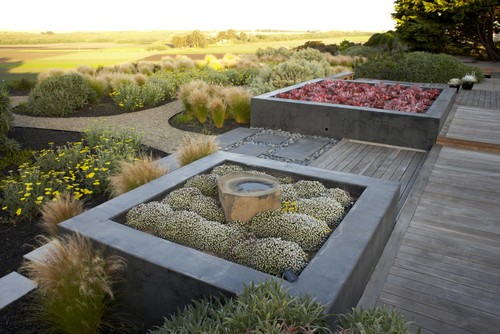
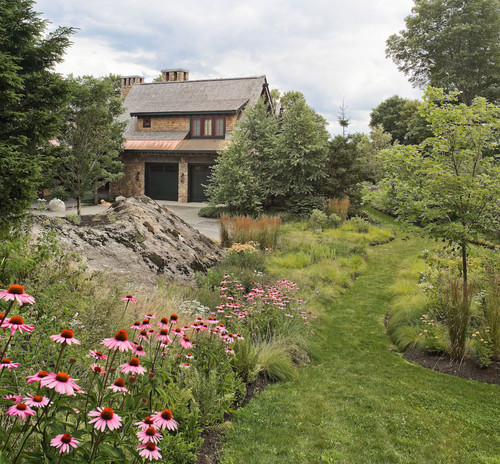
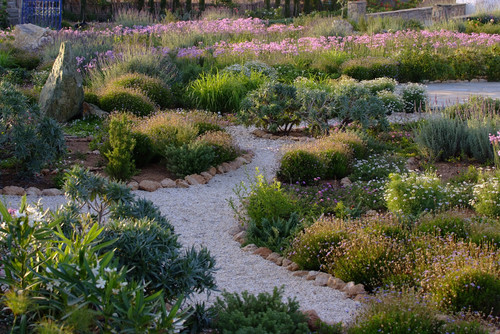
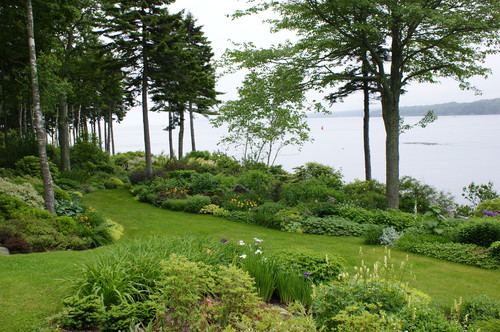
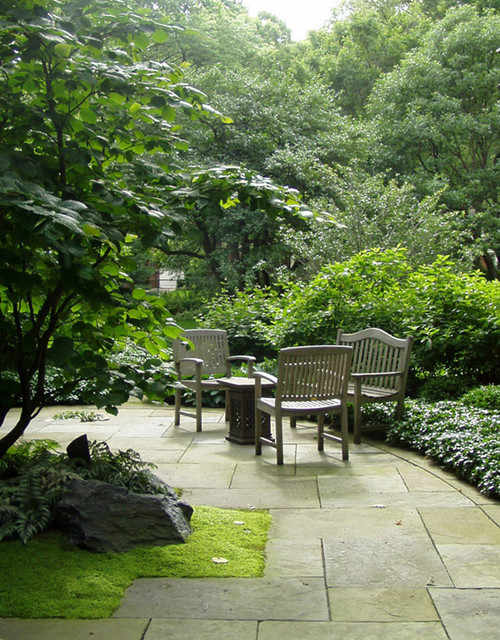
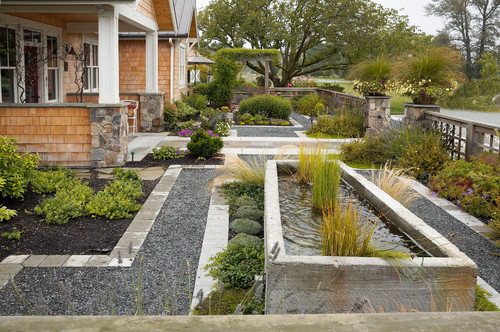
13 responses to “Wildlife Garden Design Tip: Use Less Lawn!”
Any ideas as to how to go about changing your town’s code about front lawns? I can be somewhat creative in the back, but the city fathers like manicured front lawns.
Start with a visit to your Town’s planning director. If he is agreeable to your suggestions, you can use him as a valuable ally. Next stop is the planning commission and Town counsel. It also helps ti get the local press to provide some positive input. Often these are simply archaic items that are just left over on the books.
Alison has great advice. A lot of towns have opposing viewpoints (including my own) which say that lawn should be minimized. See if you can turn up any towns that have ruled against lawns and see if you can bring their reasoning to the meeting with Planning. It is absolutely a smart idea to talk with the local media and make the case publicly prior to meeting with Planning and making a case to the city council. It’s irresponsible for a city to require people to have a stretch of resource-hogging lawn when they don’t want it.
Wow. Lawn-free living. I’ve been slowly removing turf for years, revealing the New England rocks and boulders that reside just inches below. I’ve also begun replacing my perennial beds with bushes and native plants like milkweed and Joe Pye weed. This year the toads and frogs and butterflies moved right in. What a treat. The examples you show are inspirational.
Thanks, Lauren! Your most recent article was totally inspiring to me. I loved seeing how the caterpillars each have their own style of chomping! I can’t wait to start seeing more caterpillars and butterflies in my garden. My ladies and cats don’t tend to bother them much, thank goodness. Dragonflies are another matter. I bring angry dragonflies outside again every day after Mackerel catches them. They usually seem to fly away with no problem except being spitting mad.
I’ve got rid of almost all my lawn in front, and a good deal of it in back. We do want space for hanging out, etc. Only thing is, replacing lawn with beds is not necessarily less work. I have mixed beds and they take a lot of time, though I am happy with them. Trying to use more grasses and low shrubs, which I think take less work than perennials.
You’re absolutely right. I prefer grasses and shrubs myself for the less-work factor. Though honestly since I don’t fuss much, the perennials at my own place are very little work as well. One winter WHACK and they’re done with their maintenance for the year. My garden’s pretty low-key. For clients, shrubs and grasses are definitely less fuss, as few people want to see brown anything on their perennials.
What an inspiring post, Gen, and thanks so much for the mention of Lawn Gone! I really love the examples you’ve shown here, and your point about a garden being friendlier for wildlife is right on. Down with lawn deserts!
Excellent examples of less lawn, Gen! Love the way you encourage folks to consider lawns as (smaller) useful garden elements rather than as the default treatment for an entire property. We can make places that welcome wildlife and are also comfortable havens for people.
Wonderful pictures, and really fantastic ideas to use up all that space. Although I do have a lawn and I enjoy caring for it, I do agree that if it does not make you happy or does not give you any sense of fulfillment, then its better to rip it up and replace it with something that will mean more to you. I love the idea of putting ponds and attracting pollinators by planting flowers. Thanks for sharing! I love the ideas and the pictures! Cant wait to see more.
I think you know how I feel about lawns. I’ve been doing my part to reduce their size for many, many years. You’ve shown some lovely examples here (even though they are all severely lacking in dwarf conifers).
Less Lawn More Conifers!
Ed-
We got rid of the lawn at our house, replacing it with ornamental beds in one section and an orchard in another. One ornamental bed is actually filled with edibles — nanking cherry bushes, blueberries and raspberries on a gentle slope. The driveway is lined with 4-foot deep bulb beds on either side. Lots of newspaper layers covered with mulch across the expanses. The dog doesn’t miss the lawn!
[…] Wildlife Design Tip: Use Less Lawn […]